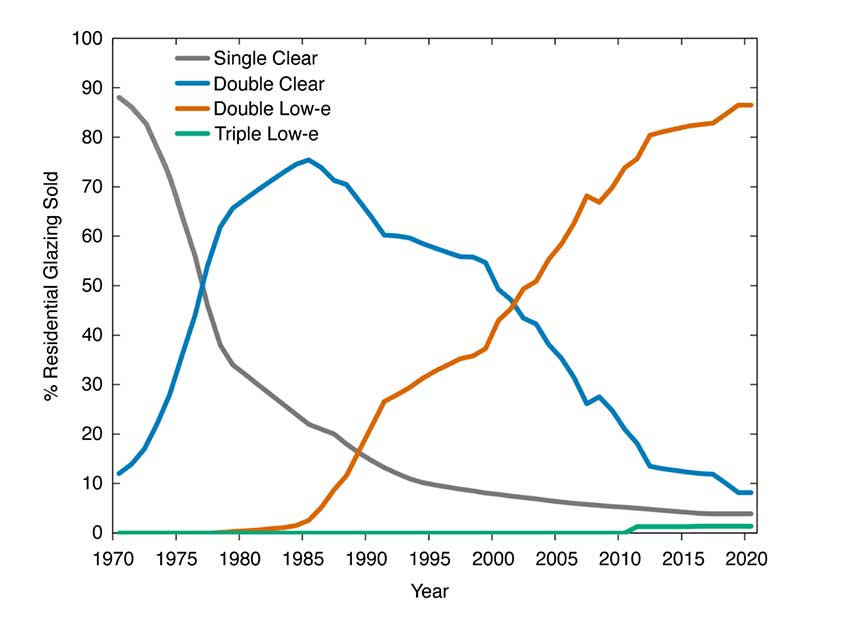Is There Such a Thing As Too Much Glass?
Learning Objectives:
- Discuss arguments that too much glass is used in office buildings, contributing to carbon emissions, material disadvantages, and adverse effects on indoor environmental quality (IEQ).
- Explain key reasons why overglazing is not always the source of building overheating and rising temperatures outside buildings.
- Describe recent progress in glass, insulated glazing units, framing and thermal breaks, dynamic glazing, coatings and associated technologies.
- Demonstrate a familiarity with the curtain wall components of evolving building codes, performance-based approaches not yet incorporated into codes, and strategies to exceed current code requirements.
- Identify contemporary construction projects that have achieved high performance with curtain wall technologies and explain how they can inform future decisions about design and specifications.
Credits:
This course is approved as a Structured Course
This course can be self-reported to the AANB, as per their CE Guidelines
Approved for structured learning
Approved for Core Learning
This course can be self-reported to the NLAA
Course may qualify for Learning Hours with NWTAA
Course eligible for OAA Learning Hours
This course is approved as a core course
This course can be self-reported for Learning Units to the Architectural Institute of British Columbia
All-glass facades are popular with owners and tenants for a host of reasons, intuitive and otherwise. Daylight outperforms artificial light in enhancing indoor environmental quality, optimizing visual acuity, entraining circadian rhythms, and enhancing other aspects of physical and psychological health, creating optimal conditions for quality of life; these advantages are supported by the relevant scientific literature (e.g., Knoop et al., 2019) as well as common-sense observations. Human eyes and bodies evolved in response to the sun, not the fluorescent tube or the light-emitting diode, and ample fenestration is how buildings accommodate this aspect of our natural biophilia.

Image courtesy of Handel Architects
Winthrop Center, currently under construction, will add a distinctive pleated-glass profile to Boston's downtown skyline.
Yet the disadvantages of extensively glazed buildings are also substantial. In an era when the urgency of climate-change mitigation and adaptation is increasingly obvious, glass facades’ thermal performance is a challenge that must be met either through higher standards or through less reliance on glazing. Technologies that can raise the R-value of common double-pane glass from the R2 level to the R5-7 range are available, though not yet widely adopted; approaches that can perform as high as R14 are confined to niche markets. The last major advance, low-emissivity (low-E) coating, occurred four decades ago, eventually achieving a market share of about 50 percent in the commercial sector and 85 percent in the residential sector (Harris et al., 2022). Thermal bridging, particularly through aluminum frames that lack thermal breaks, makes even high-performing glass (measured at the center of a window or insulated glazing unit [IGU]) relatively inefficient when measured at the edge of the glass or on the full-unit scale. Operational carbon footprints are only part of the problem; considerations of embodied carbon underscore the importance of durable buildings and materials, and too many glazed buildings are anything but durable.

Image courtesy of Harris et al., U.S. Department of Energy, 2022
Figure 1. The 50-year trends in market share for four glazing types. Low-E coatings have seen rapid adoption since their introduction, while triple-pane IGUs have remained a small portion of the overall market. Commercial glazing shows similar relative trends in the adoption of low-E coatings and triple-pane glazing, but with lower overall adoption of both technologies. Source: Harris et al., 2022, based on figures from Selkowitz et al., 2018.
Since buildings account for roughly 40 percent of total U.S. energy consumption, and heating/ventilation/air-conditioning (HVAC) systems account for the largest share of total building energy use, about 35 percent (Selkowitz et al., 2018), reducing energy wastage through glass windows, doors, IGUs, and associated components can make a substantial contribution toward reducing HVAC reliance and cutting greenhouse gas (GHG) emissions. Yet efficiency upgrades face barriers in not only costs but market fragmentation, misaligned incentives for retrofitting of existing buildings, and limited awareness of the potential benefits among owners, engineers, and architects. Views among specialists in facades’ energy performance range from optimism toward imminent paradigm shifts to skepticism about the general desirability of glazed facades. Some argue that many commercial buildings are simply overglazed.
From one rigorous perspective, today’s facades–even the unitized curtain wall systems that have improved dramatically on thermal performance–are an essentially unsustainable technology. “We are, in my opinion, quite literally building tomorrow's problems today,” says Mic Patterson, PhD, ambassador of innovation and collaboration at the Facade Tectonics Institute (FTI) and lecturer at the University of Southern California School of Architecture. Patterson has become increasingly “wary of the optimism gene” and skeptical about incremental measures when conditions call for more radical transformations in design and construction practices. Too many buildings are designed for a short service life, he finds, with no plans for retrofitting, no repair capabilities comparable to the “plug-and-play” systems found in other product categories such as information technology or audio systems, and a perverse set of economic incentives that disregards energy and emissions.
Citing remarks by Antony Wood of the Council on Tall Buildings and Urban Habitat (CTBUH), Patterson says, buildings should not be designed for just a few decades; instead, “they should last until we’re done with them…We’re making a massive commitment of resources” in constructing high-rise buildings, Patterson observes, “and to not define a service life for them─60 years, or maybe a stretch to 100 years─is really shortsighted. I think we should be talking about hundreds of years, if not thousands, and even better, perpetual service life until we’re done with them. That calls for an entirely different kind of thinking…Embodied carbon is telling us that our systems that we’re designing aren’t nearly adaptable enough.”
During power outages, heavy HVAC dependence can compromise more than performance and comfort, adds Stéphane P. Hoffman, M.Arch., M.Eng., PE, principal, senior building science specialist, and vice-president at Morrison Hershfield, the Toronto-based engineering firm that served as principal investigator for a 2011 American Society of Heating, Refrigerating, and Air-Conditioning Engineers (ASHRAE) report providing thermal-transmittance data on envelope details (Lawton et al., 2011). “Some of these highly glazed buildings are fine as long as the lights are on, but if you lose that power, they rapidly become uninhabitable,” even hazardous to life during disasters or severe weather.
Progress in the thermal efficiency of glazing has been steady, though it still has far to go to help the nation reach its environmental goals. Proportions of glazing types, driven by technological improvements, code evolution, and EnergyStar incentives, have changed dramatically over the past five decades, particularly in the residential sector (Figure 1), where double-pane windows rapidly overtook single-pane during the 1970s and 1980s, followed by low-E double-pane windows replacing clear double-pane. The energy savings are a component of broader nationwide reductions in energy wastage due to improved efficiency during the same decade (relative to how much energy would have been squandered if 1975 standards for efficiency and structure had remained in effect), which outstrip the effects of growth in renewable energy sources (Figure 2).

Image courtesy of Stephen Selkowitz
Figure 2. Reduced energy intensity has had 30 times the impact of growth in renewables in the U.S. from 1965 to 2018. Source: Selkowitz S. New IGU Technologies for Carbon Reduction and Zero Net Energy. National Glass Association conference, Jan. 26, 2022.
There is arguably considerably more low-hanging fruit in the commercial sector, where an estimated 41 percent of the existing building stock still has single-pane glass (Guidehouse 2021). If thermal efficiency continues to improve, it is conceivable that windows can approach zero net energy or even theoretically become net positive. Passive House standards and practices, common in northern Europe but not integrated into code in the U.S., offer models that specialists find worth emulating, though caveats exist about embodied carbon in materials often used in Passive House projects, offsetting gains in operational carbon (Bernstein 2022). The British Columbia Step Code, for example, a performance-based system using a Thermal Energy Demand Intensity [TEDI] metric, approximates Passive House-level rigor. There are reasons to view the glass, as it were, as either half empty or half full.



















